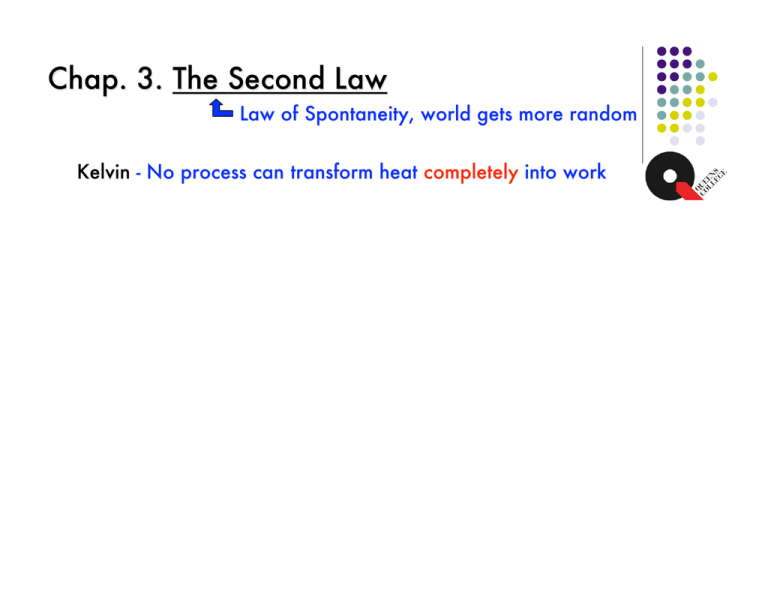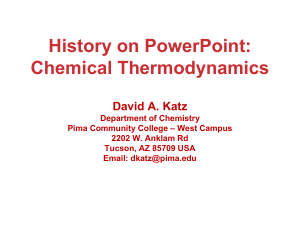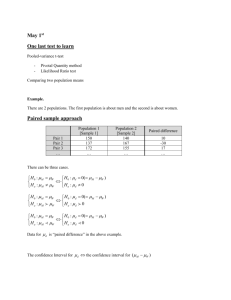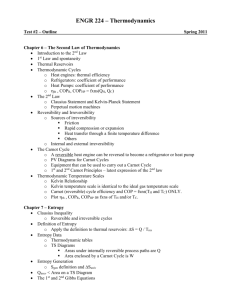Chap. 3. The Second Law
advertisement

Chap. 3. The Second Law Law of Spontaneity, world gets more random Kelvin - No process can transform heat completely into work Chap. 3. The Second Law Law of Spontaneity, world gets more random Kelvin - No process can transform heat completely into work The entropy of an isolated system increases in the course of a spontaneous change. - Entropy, the degree of randomness - State function, completely specified by thermodynamic variables - Unit: Energy/temperature (K) - Thermodynamic definition: Chap. 3. The Second Law Law of Spontaneity, world gets more random Kelvin - No process can transform heat completely into work The entropy of an isolated system increases in the course of a spontaneous change. - Entropy, the degree of randomness - State function, completely specified by thermodynamic variables - Unit: Energy/temperature (K) - Thermodynamic definition: For surroundings, because The above relation holds even for finite amount of heat For surroundings, because The above relation holds even for finite amount of heat For adiabatic process, For surroundings, because The above relation holds even for finite amount of heat For adiabatic process, Isothermal expansion of an ideal gas Carnot Cycle (Ideal Gas) 1 I - (VI ,T1) II - (VII ,T1) 4 IV - (VIV ,T2) 2 3 Fig. 3.6 (with different notations) III - (VIII ,T2) 1,3 - Reversible and isothermal processes 2,4 - Reversible and adiabatic processes Carnot Cycle (Ideal Gas) 1 I - (VI ,T1) II - (VII ,T1) 4 IV - (VIV ,T2) Fig. 3.6 (with different notations) 2 3 III - (VIII ,T2) 1,3 - Reversible and isothermal processes 2,4 - Reversible and adiabatic processes and Carnot Cycle (Ideal Gas) 1 I - (VI ,T1) II - (VII ,T1) 4 IV - (VIV ,T2) Fig. 3.6 (with different notations) 2 3 III - (VIII ,T2) 1,3 - Reversible and isothermal processes 2,4 - Reversible and adiabatic processes and Carnot Cycle (Ideal Gas) 1 I - (VI ,Tup) II - (VII ,Tup) 4 IV - (VIV ,Tlo) 2 3 III - (VIII ,Tlo) Fig. 3.6 (with different notations) Carnot Cycle (Ideal Gas) 1 I - (VI ,Tup) II - (VII ,Tup) 4 IV - (VIV ,Tlo) 2 3 Fig. 3.6 (with different notations) III - (VIII ,Tlo) and See further information 2.1 (page 69) , where Carnot Cycle (Ideal Gas) 1 I - (VI ,Tup) II - (VII ,Tup) 4 IV - (VIV ,Tlo) 2 3 Fig. 3.6 (with different notations) III - (VIII ,Tlo) and See further information 2.1 (page 69) , where Carnot Cycle (Ideal Gas) 1 I - (VI ,Tup) II - (VII ,Tup) 4 IV - (VIV ,Tlo) 2 3 III - (VIII ,Tlo) Carnot Cycle (Ideal Gas) 1 I - (VI ,Tup) II - (VII ,Tup) 4 IV - (VIV ,Tlo) 2 3 III - (VIII ,Tlo) Carnot Cycle (Ideal Gas) 1 I - (VI ,Tup) II - (VII ,Tup) 4 IV - (VIV ,Tlo) Efficiency: 2 3 III - (VIII ,Tlo) Carnot Cycle (General) 1 I - (VI ,Tup) II - (VII ,Tup) 4 IV - (VIV ,Tlo) 2 3 III - (VIII ,Tlo) (First law) Efficiency: S is not a state function Carnot cycle B with Carnot cycle A with I - (T (Tup) 1 4 IV - (T (Tlo) II - (T (Tup) 2 3 III - (T (Tlo) I’ - (T (Tup) 1’ 2’ 4’ IV’ IV’ - (T (Tlo) II’ II’ - (T (Tup) 3’ III’ III’ - (T (Tlo) Carnot cycle B with Carnot cycle A with 1 I - (T (Tup) 4 IV - (T (Tlo) 2 3 I’ - (T (Tup) II - (T (Tup) III - (T (Tlo) + 1’ 4’ IV’ IV’ - (T (Tlo) 2’ 3’ Combine A and reverse of B, and assume Then, This contradicts the second law by Kelvin! II’ II’ - (T (Tup) III’ III’ - (T (Tlo) Carnot Cycle (General) 1 I - (VI ,Tup) II - (VII ,Tup) 4 IV - (VIV ,Tlo) 2 3 III - (VIII ,Tlo) Efficiency: Any cycle can be considered as the sum of infinitesimal Carnot cycles (Fig. 3.9) Clausius Inequality: Clausius Inequality: (i) System does maximum work for reversible process. (ii) Consider a change of system through a reversible process (1) The same change can happen through another process. (2) Clausius Inequality: System does maximum work for reversible process. (i) (ii) Consider a change of system through a reversible process (1) The same change can happen through another process. (2) (1)=(2) For adiabatic process (i) Entropy change due to phase transition Normal transition temperature: temperature at which two phases are in equilibrium at 1 atm. Heat transfer during phase transition is reversible Constant pressure Entropy change due to heating Constant pressure If Cp is independent of temperature Entropy of a gas (Debye extrapolation) Nernst heat theorem Third law of thermodynamics Standard (third law) entropy - the entropy in the standard state under the assumption that S=0 at T=0. Entropy of reaction for Standard of entropies of ions are defined such that Helmholtz free energy Determines the spontaneous (free) process at constant volume (no non-expansion work) Gibbs free energy Determines the spontaneous (free) process at constant process (no non-expansion work) Helmholtz free energy Determines the spontaneous (free) process at constant volume (no non-expansion work) Maximum work system can do in isothermal situation Gibbs free energy Determines the spontaneous (free) process at constant process (no non-expansion work) Maximum non-expansion work system can do in isothermal and isobaric situation Standard Gibbs energy of reaction Standard Gibbs energy of formation The standard Gibbs energy of formation for ions are defined such that zero standard Gibbs energy of formation at all temperature Fundamental equation closed system, no non-expansion work, reversible change valid even for irreversible change Assume and Assume that and (2) (3) (4) (2’ (2’) (3’ (3’) (4’ (4’) (2) (3) (4) (2’ (2’) (3’ (3’) (4’ (4’) (2’ (2’) (3’ (3’) (4’ (4’) Gibbs-Helmholtz equation Important equation for understanding phase transition At constant temperature, Molar Gibbs energy Molar volume For liquids or solids, Vm is insensitive to pressure change For an ideal gas, When






